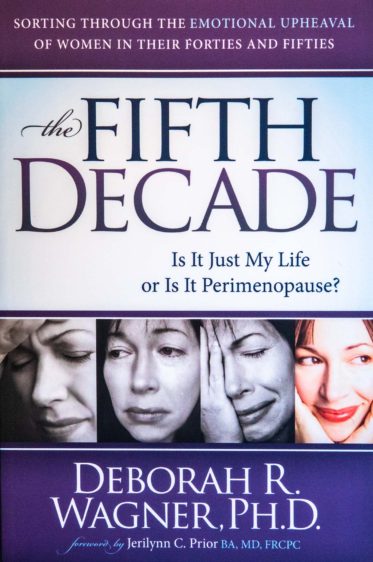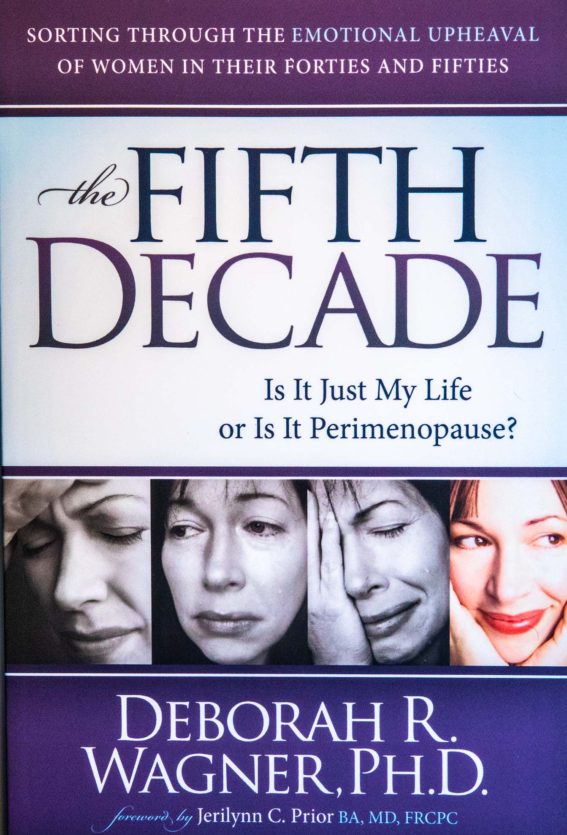The Fifth Decade
Premenstrual Syndrome
Women in their late thirties and early forties often notice a worsening of PMS symptoms. On a physical level, this may include more cramping, bloating and breast tenderness. On a psychological level, this involves increased moodiness and feelings of depression. With the onset of perimenopause, each passing year brings a more upleasant premenstrual period.
New research shows that menopause is not an event just for women in their late forties and early fifties. Perimenopause, the period of time before menopause, may begin ten or more years before menopause. Perimenopause engages slowly and subtly, as the female hormones finish the era of regular, predictable, cyclical secretions and begin ever so slightly to shift. The first years of perimenopause may go unnoticed. It is frequently not until there are noticeable changes in the timing or duration of menses that women are alerted to these changes.
These changes in menses are what eventually alert women to notice they are having more emotional difficulties around the time of their monthly period. Women that have never before suffered from PMS, find that now they do. In some cases, the moodiness of PMS may reach proportions significant enough to be diagnosable as depression. As perimenopause progresses, women are subjected to 'higher highs' when estrogen and progesterone are at their optimal level and 'lower lows' when at their least optimal level. This is a normal part of the perimenopause transition, albeit a difficult one.
Anxiety
Many women in perimenopause experience mild to severe anxiety, some for the first time. Anxiety is more likely to occur as the female hormones begin to shift. Initially, estrogen levels become highly volatile, with significant increases and decreases. Eventually, estrogen levels start to taper off. The radical shifts in estrogen levels contribute to feelings of anxiety simultaneously with a reduction in the calming influence of progesterone.
Progesterone levels start to decline from the onset of perimenopause through menopause. Progesterone, often referred to as the "feel good hormone" acts in the body as an anxiolytic and antidepressant. It calms and quiets frazzled nerves. It is easy to understand that as progesterone levels decrease in the body, the protection against stress is decreased.?The forms anxiety takes can be varied. Where one woman may suffer panic attacks, another may develop insomnia, while another will become unusually stressed in conducting daily tasks. Panic attacks, one of the more severe types of anxiety, can be quite debilitating and are frequently associated with hot flashes in perimenopause. They can interfere with a woman's ability to work, function within the home or engage in social functions. Other forms of anxiety, depending on severity, can be mildly or significantly challenging, as well.
The risk for developing anxiety increases when the middle aged, perimenopausal woman is also experiencing other stressors such as empty nest, sick elderly parents, children in puberty, changes in career, financial instability or challenges in personal relationships. In general, this is a very difficult milestone in women's lives. There is a wide range of what women can expect to feel and experience.
The Interaction Between Hormones and Emotions
Progesterone, a female hormone that is highly influential in moderating our emotions, declines steadily throughour forties and fifties. Progesterone serves as the counterbalance to estrogen. Women are left feeling raw and exposed to the powerful effects of vacillating estrogen levels as progesterone diminishes. This is one of the major contributors to anxiety that women experience in perimenopause.
Progesterone is often referred to as the “feel good hormone” Progesterone stabilizes emotions, acting as a natural antidepressant and anxiolytic. Have you ever wondered why women in the late stages of pregnancy report feeling wonderful in spite of the physical discomfort they experience? This is due to the high levels of progesterone. Similarly, progesterone is implicated in postpartum depression as its levels drop off dramatically after birth. The effects of progesterone on a woman’s mood cannot be underestimated. The sedating effects of progesterone make us feel mellow, impenetrable to stress and even a bit laid back. A woman's mood changes as progesterone waxes and wanes through the menstrual cycle. Understanding this process lays a foundation for understanding the changing moods, anxieties and a woman’s difficulty in tolerating challenges as she progresses through perimenopause. She becomes a stranger not only to her loved ones; she is a stranger to herself.
This year nearly 30 million women between 39 and 53 will experience clinical depression and anxiety disorders associated with the onset of perimenopause.
The Fifth Decade offers women and their families an accessible guide to the turbulent years of perimenopause, as well as seasoned insight to navigate the intense, unpredictable emotional swings that define these years.
Dr. Wagner discusses, with clear and factual explanations: changing sexuality, depleted energy, lack of focus, and even women’s changing capacity to empathize with the people around them…peppering her narrative with sanity-affirming stories of keys lost in the fridge and women discovering they’ve poured orange juice into their coffee.
Dismissing the one-size-fits-all approach, Dr. Wagner provides information on treatment approaches, including the most current medical insights into hormonal changes and hormone therapy options. She also explains how every woman’s own personality, history, hormonal mix, health (including thyroid health) and her current social situation will shape her experience and her approaches for managing her wellbeing.
Perhaps most inspiring is Dr. Wagner’s reminder that the volatile years of perimenopause do, ultimately, resolve into Quietude, and women are able to look forward to the calm after the storm.
With warm and conversational chapters dedicated to spouses and children, as well as an intuitive real-world discussion of the added stressors that define daily life for women in the new millennium, The Fifth Decade is a welcome and indispensable guide for 40-something to 50-something women coping with the poignant growth, and the most intense life, body and identity shifts they will experience since their teen years.
Depression
Rates of depression in women soar when they are in their forties and fifties, and going through perimenopause. In the general population, depression is estimated to occur in as many as thirty-three percent of individuals. Females are far more susceptible to suffering from Depressive Disorders than are males.
There are four major risk categories for depression in women in this phase of life: biological, vasomotor, psychosocial and psychodynamic factors. While there is some overlap between risk factors for both depression and anxiety, it is critical to elaborate how each disorder evolves under such risk factors. In this way, women may more easily recognize the challenges in themselves and identify with their own experiences.
There are a number of biological factors that influence the onset of depression. These include hormonal changes, personal, and family history. For example, in women, depressive symptoms are most frequent in the periods of menarche, perimenopause, and postpartum; times of dramatic hormonal changes. This is because estrogen has a mood enhancing outcome via its effect on serotonin. There is so strong a correlation between depression in PMS and perimenopause that depression in PMS can be a predictor for depression in perimenopause. In one study as many as forty-five percent of perimenopausal women were diagnosed as clinically depressed. Other research has shown that women with no prior history of depression were four times as likely to exhibit some signs of depression during perimenopause.
Another risk factor in the development of depression during perimenopause is the presence of vasomotor symptoms. Vasomotor symptoms, which include flushes, commonly referred to as ‘hot flashes’ and night sweats, can increase sixfold, the risk of suffering from an episode of depression. Night sweats can produce extreme amounts of perspiration and sweating, creating significant disruptions in sleep. This leads to exhaustion and challenges to daily functioning. This ‘domino-theory’ becomes a tangled web in which it becomes difficult to tease apart what part of the depressive symptoms are due to the hormonal changes of perimenopause and what part is due to the effects of severe sleep disruption and deprivation.
Psychosocial factors can also be huge contributors to the onset of depression in women in their forties and fifties. In our culture, the passage through perimenopause, which coincides with this age range, often goes along with some enormous life challenges. For women who are mothers, one of these challenges is the ‘empty nest syndrome’. The ‘empty nest syndrome’ refers to the adjustments a mother must make emotionally, psychologically, and practically when her stage of active parenting comes to an end. In my clinical practice, I have seen happy, healthy, engaged women undergo some significant challenges when their nests initially become empty. Mood disorders are not infrequently the outcome. Women who have raised children typically have spent over twenty-five years bringing all of their children from birth to emancipation. The smallest things become a reminder of the children's absence, such as taking out that extra dinner plate when setting the table. How many times a day does a mother look at the clock, thinking ‘Dan will be home any minute’, only to realize Dan will not be home until Thanksgiving break. The entire rhythm of each day, each week changes. Can mothers redefine themselves now that their children are on their own and how do they go about doing so? How does a mother become an “I” when for the last twenty-five years she has always thought of herself as a “we”?
A notable challenge that married women face at this juncture of their lives is the re-negotiation of the marital relationship with their husbands. When a couple initially brings children into their union, the relationship shifts from one of friends and lovers to coparents of their mutual children. This relationship shift undergoes a reversal when the children grow up and leave the home. This additional challenge can initially leave a woman feeling lost, alone and disconnected from her husband. This is one of the many psychodynamic issues that adds to the risk of suffering from depressive symptoms at this time of life.


